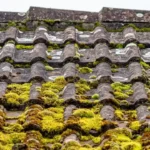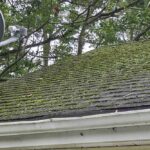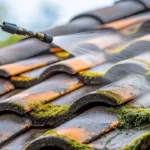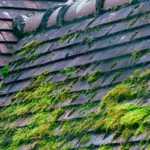Understanding the seasonal growth patterns of roof moss is crucial for homeowners aiming to maintain their roofs effectively. With the unpredictability of weather, knowing when and how moss grows can help in planning preventive measures. Let’s delve into the curious case of roof moss seasonal growth patterns to equip you with all the necessary insights.

What is Roof Moss?
Roof moss is a type of plant that thrives in damp and shaded environments. It usually appears as a green, velvety layer on roofs, especially those that are north-facing or under trees. While it may seem harmless, moss can retain moisture against your roof, leading to potential damage over time.
How Does Moss Affect Your Roof?
The presence of moss on your roof can lead to several issues, including water leaks, rot, and even structural damage. Moss holds moisture like a sponge, which can seep into roofing materials, causing them to degrade faster. For more details on how moss can impact your home’s foundation, you can visit this link.
The Lifecycle of Roof Moss
Spring Growth
Spring is a prime time for moss growth due to increased rainfall and moderate temperatures. The combination of moisture and warmth creates an ideal environment for moss to thrive.
Summer Dormancy
During summer, the heat and sun exposure can cause moss to dry out and become dormant. However, if your roof is shaded or you live in a cooler climate, moss may continue to grow.
Fall Revival
As temperatures drop and rain returns in the fall, moss often revives and begins to grow again. This is a critical time for homeowners to inspect their roofs and address any moss growth before winter.
Winter Survival
In winter, moss survives under snow and ice. The cold, moist conditions can maintain moss growth, making it crucial to monitor and manage moss before it becomes a bigger problem.
Preventing Moss Growth
Preventing moss growth involves keeping your roof clean and ensuring it has adequate sunlight. Regularly trimming overhanging branches and cleaning gutters can minimize moisture retention on your roof. For a detailed guide on safely removing moss, see this article.
Is Professional Removal Necessary?
While some homeowners may choose to remove moss themselves, professional removal is often recommended for safety and effectiveness. Professionals can ensure that moss is removed without damaging roofing materials, and they can apply treatments to prevent future growth. Learn more about safety precautions in this checklist.
How Climate Affects Moss Growth
Regional climate plays a significant role in moss growth patterns. In areas with high humidity or frequent rain, moss can grow year-round. Coastal regions are particularly susceptible due to constant moisture. For insights on moss in coastal climates, you might want to read this page.
Impact on Roof Warranties
Moss-related damage can void roof warranties if not addressed promptly. Regular inspections and maintenance can protect your warranty and your investment. For more on this topic, refer to roof moss and warranties.
FAQs
Does moss grow on all types of roofs?
No, moss is more common on roofs made of materials like asphalt, wood, and clay due to their porous nature.
Can moss damage my roof?
Yes, moss can hold moisture against the roof surface, leading to rot and potential structural damage.
What’s the best season to remove moss?
Late spring to early summer is ideal for moss removal when it’s easier to spot and remove due to its dry state.

Conclusion
Understanding the roof moss seasonal growth patterns is essential for effective roof maintenance. By staying informed and proactive, homeowners can protect their roofs and extend their lifespan. For more information on why roofs get mossy, consider reading this external article.
This article contains affiliate links. We may earn a commission at no extra cost to you.








